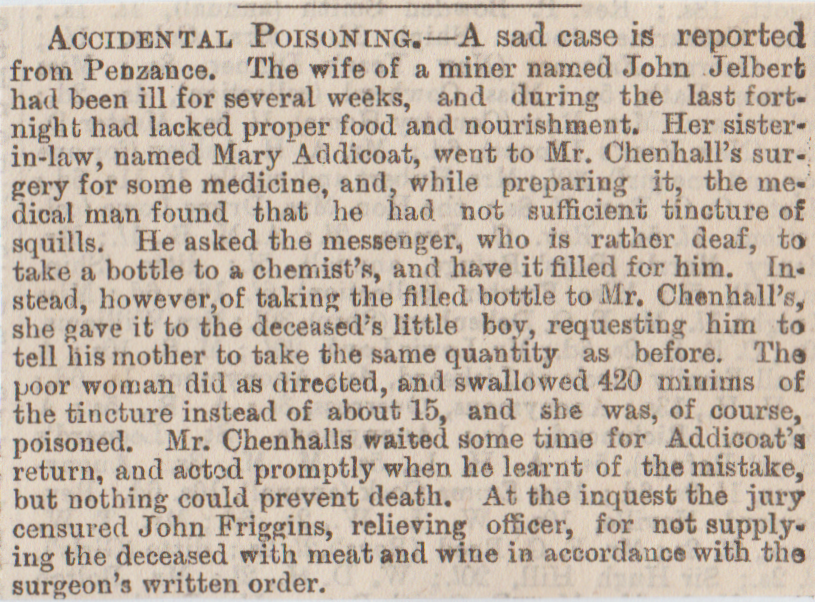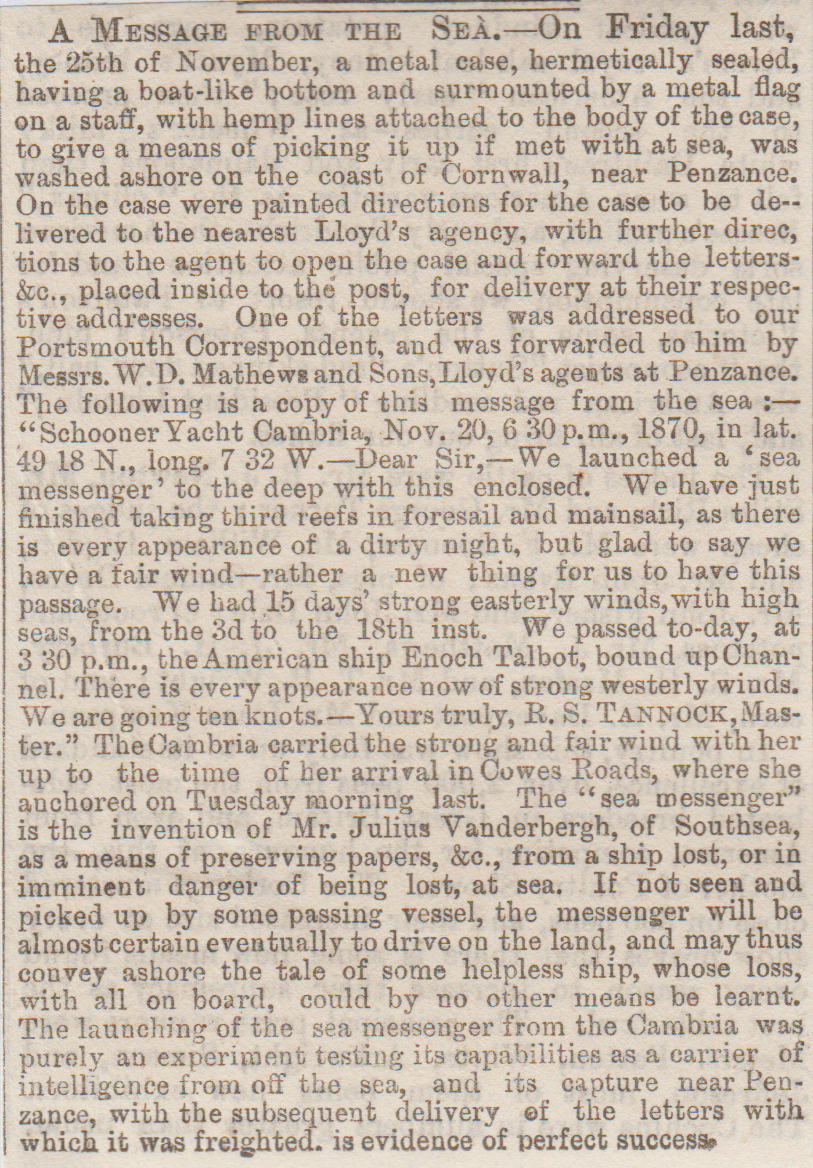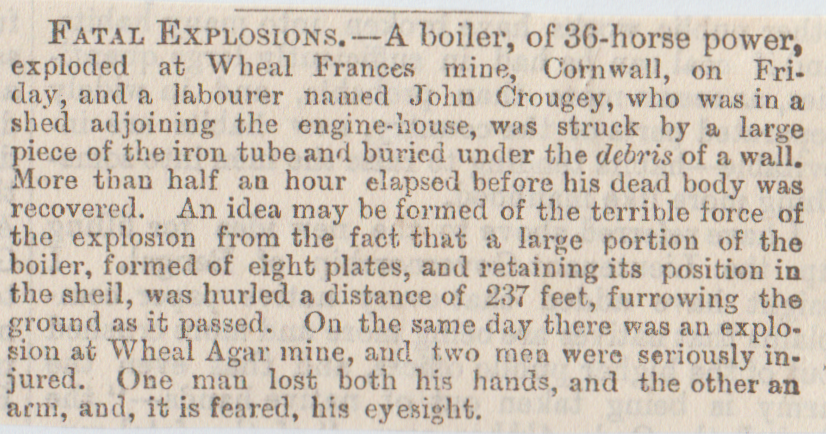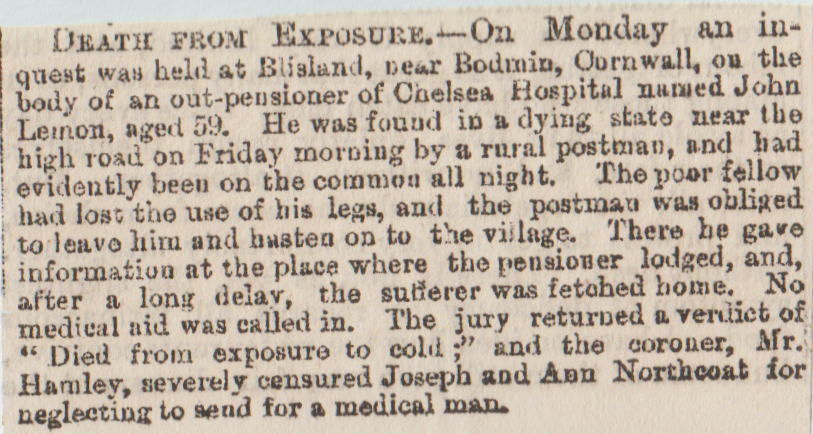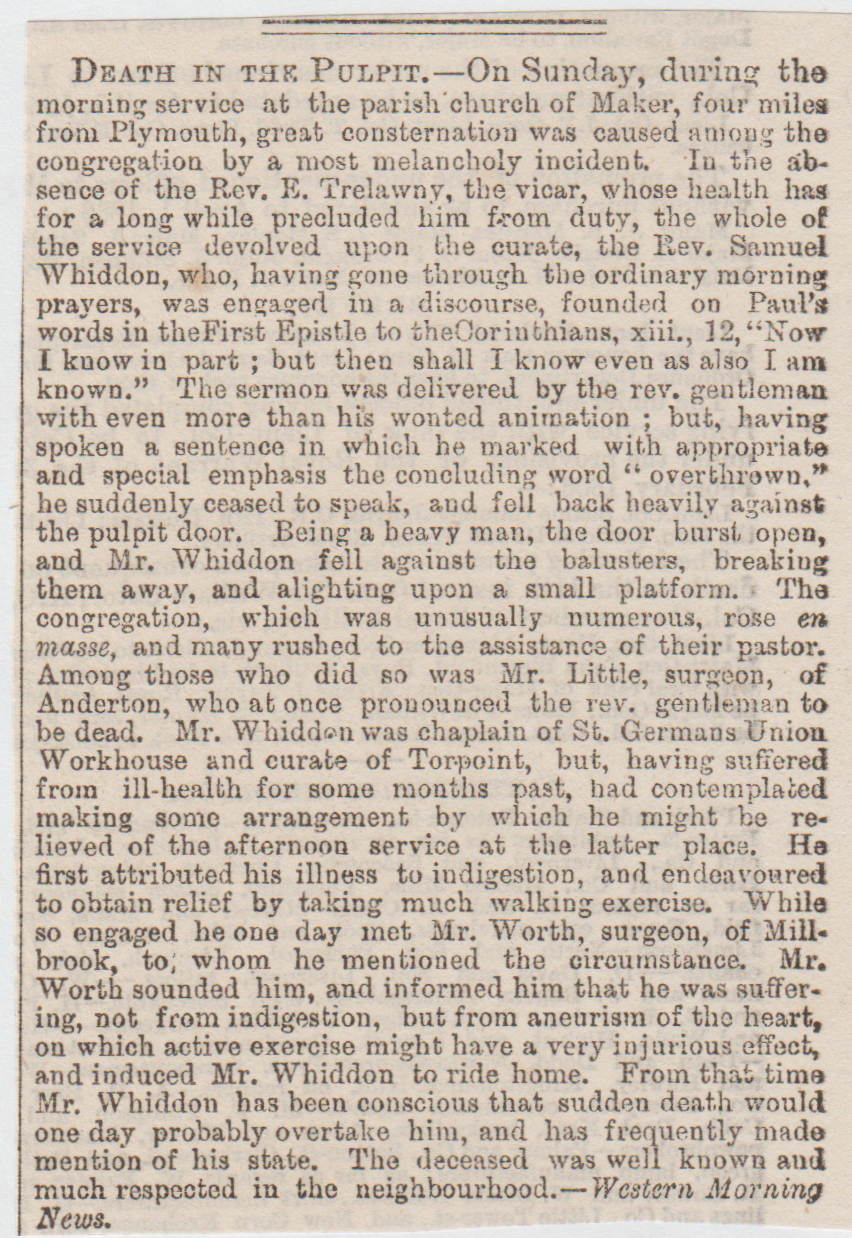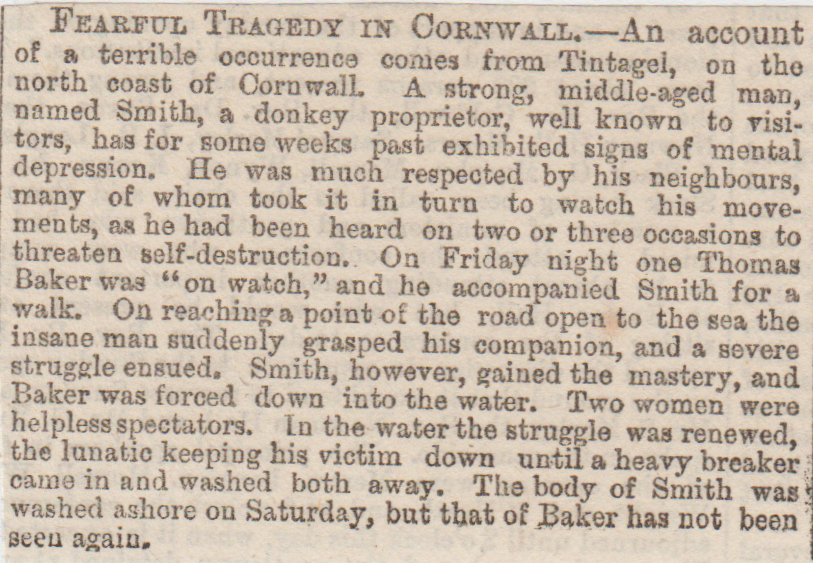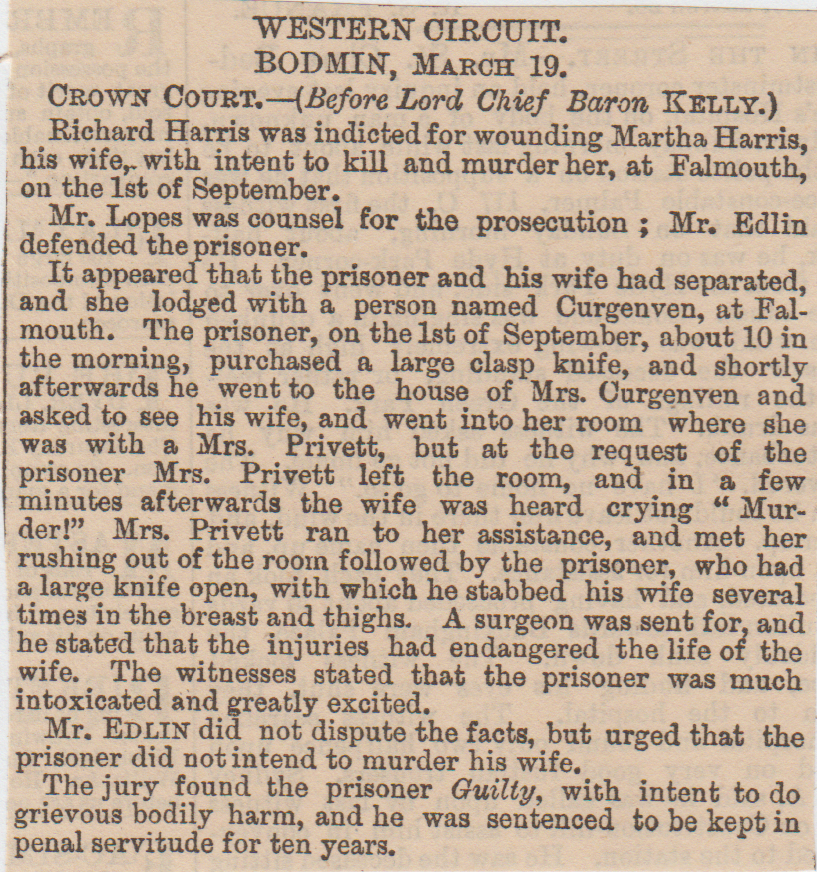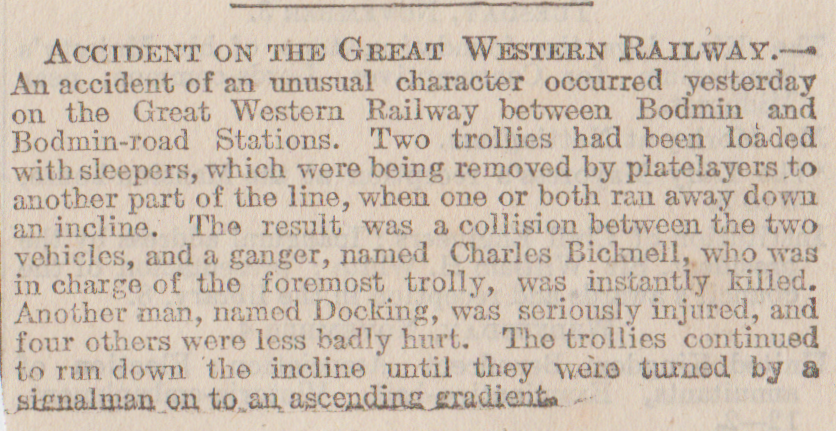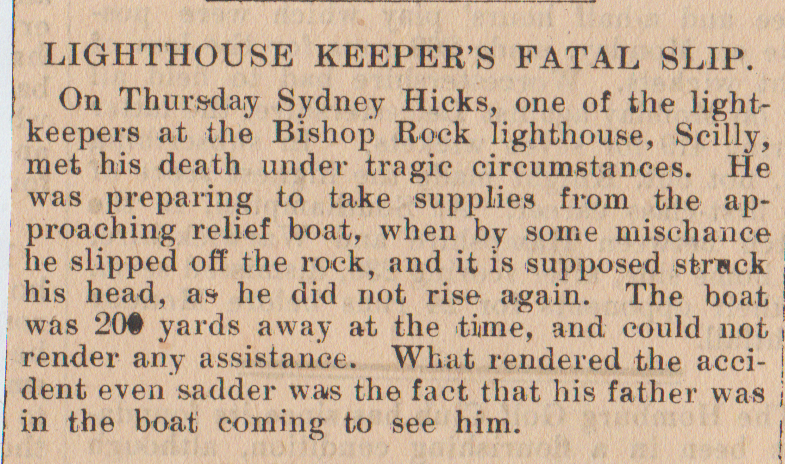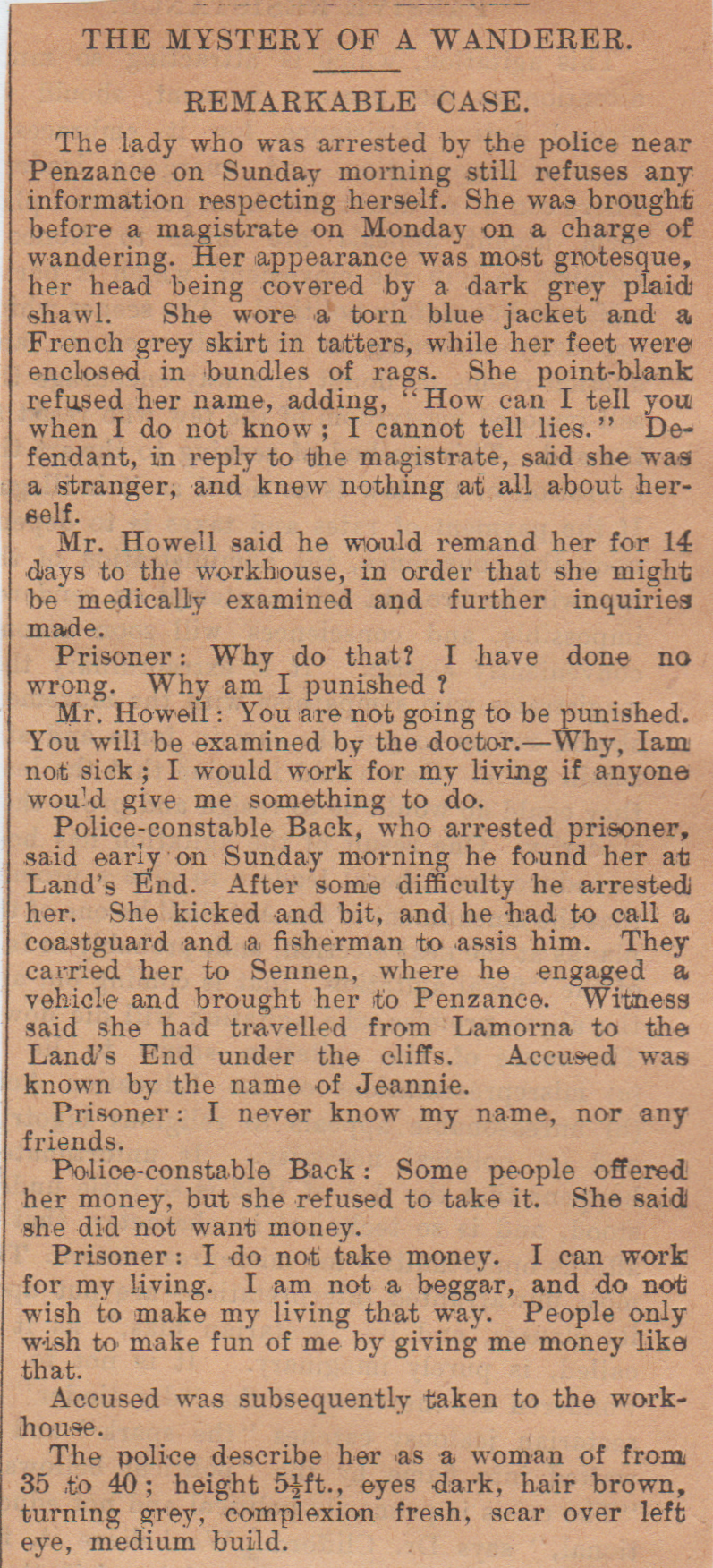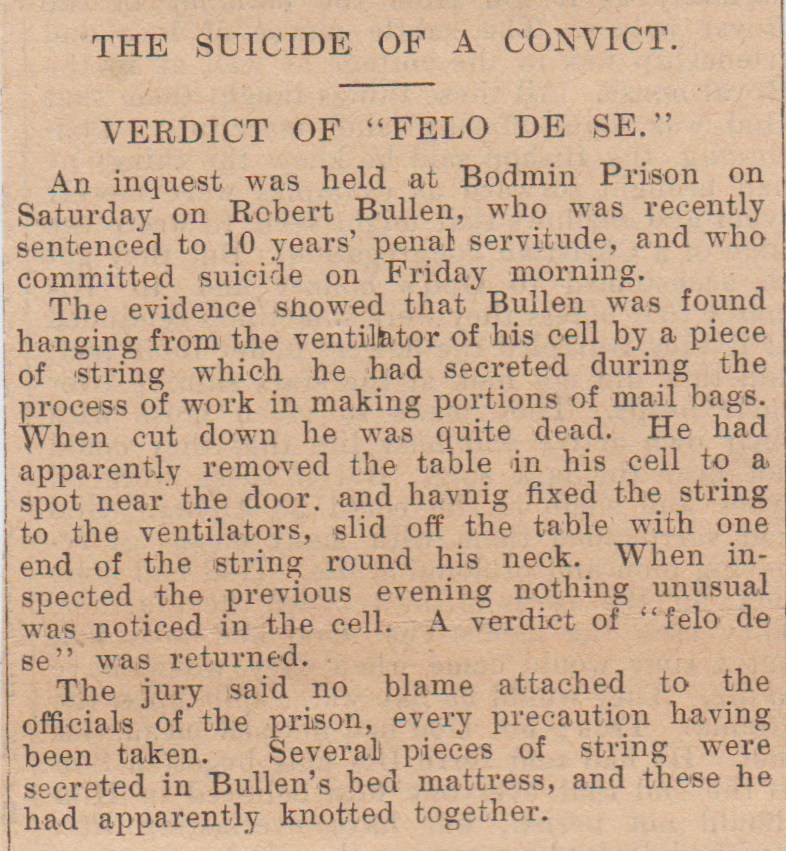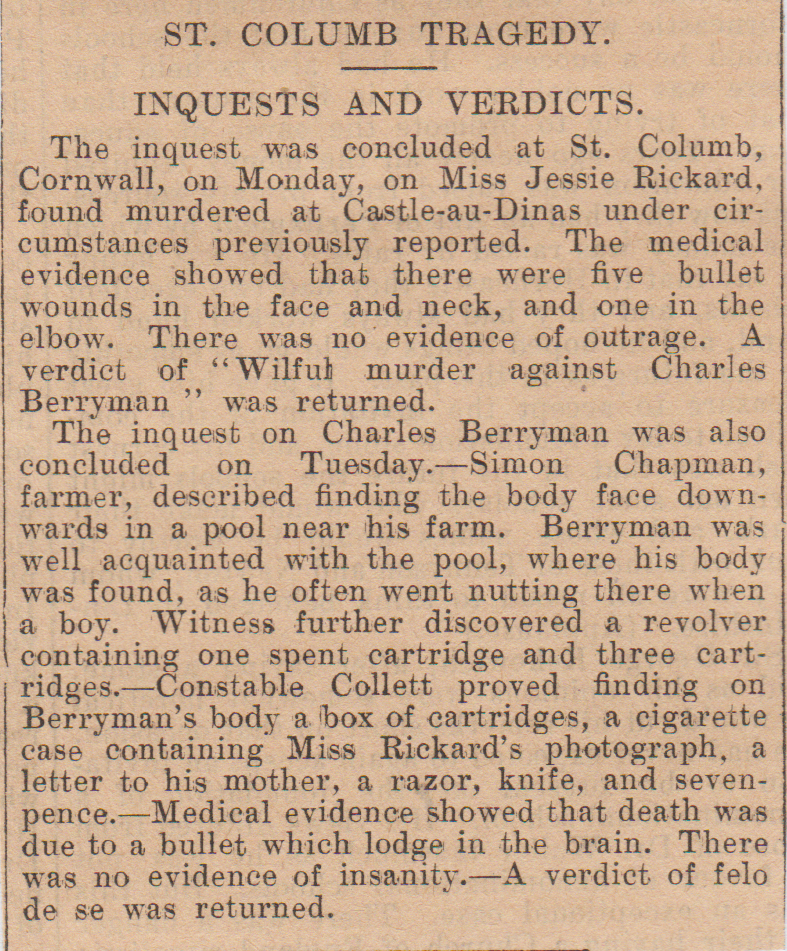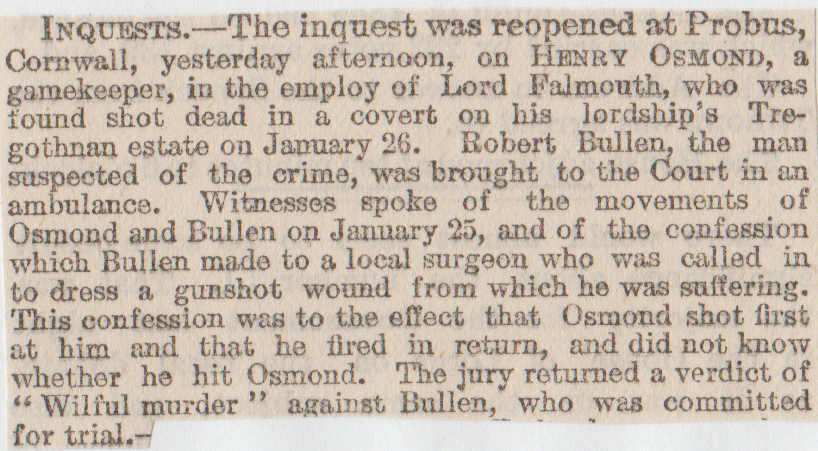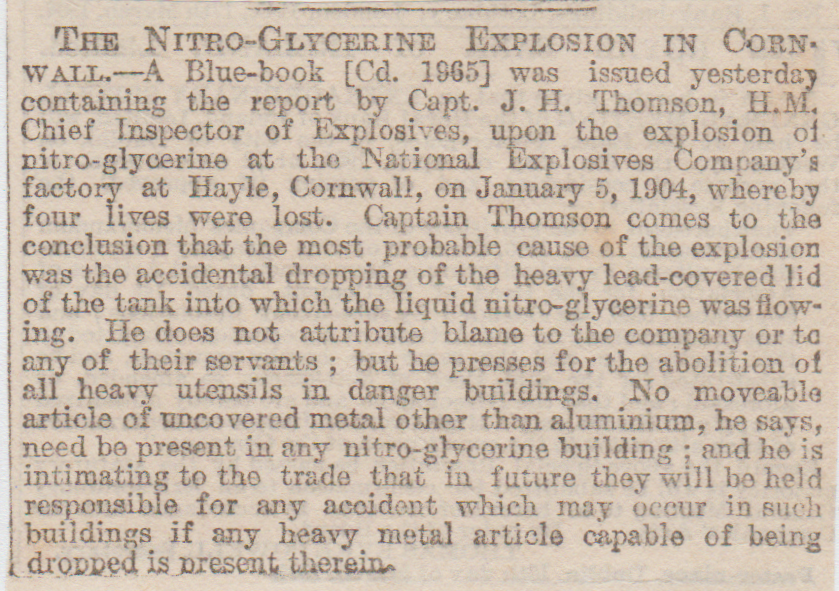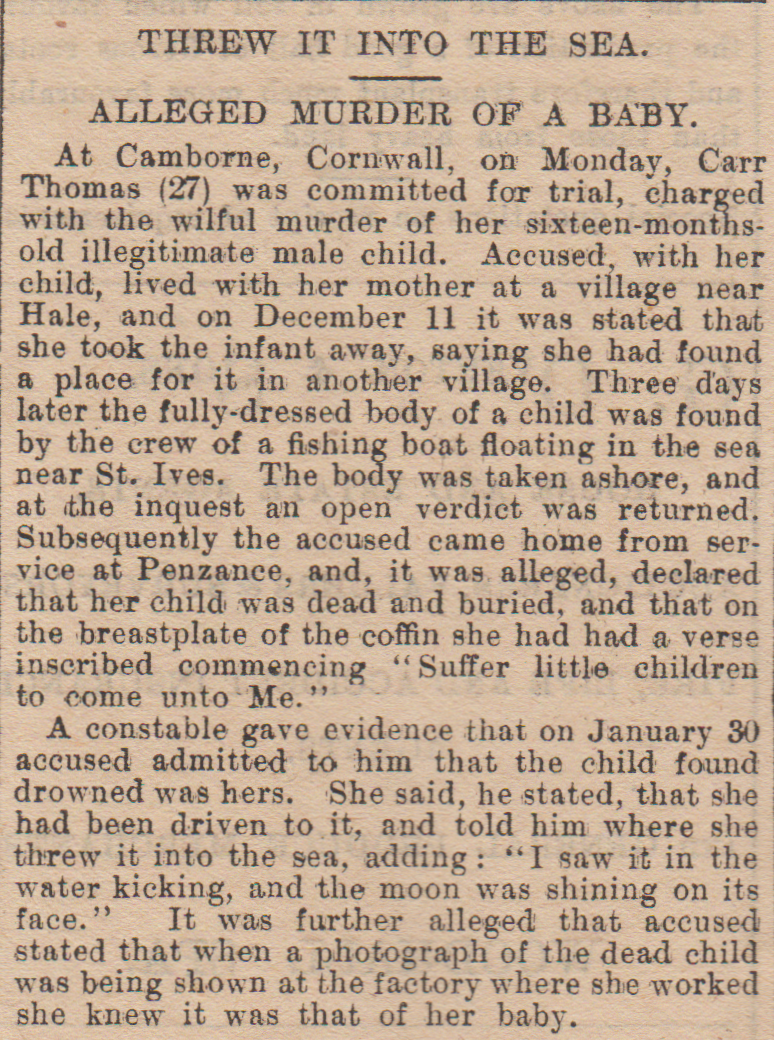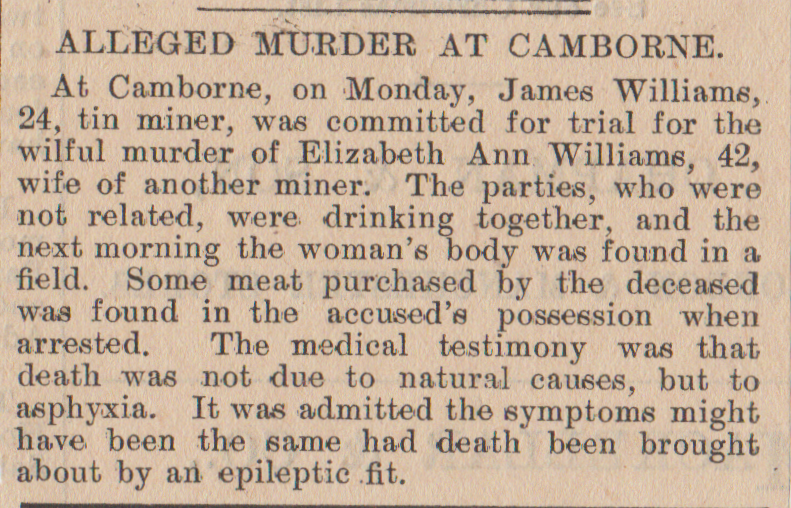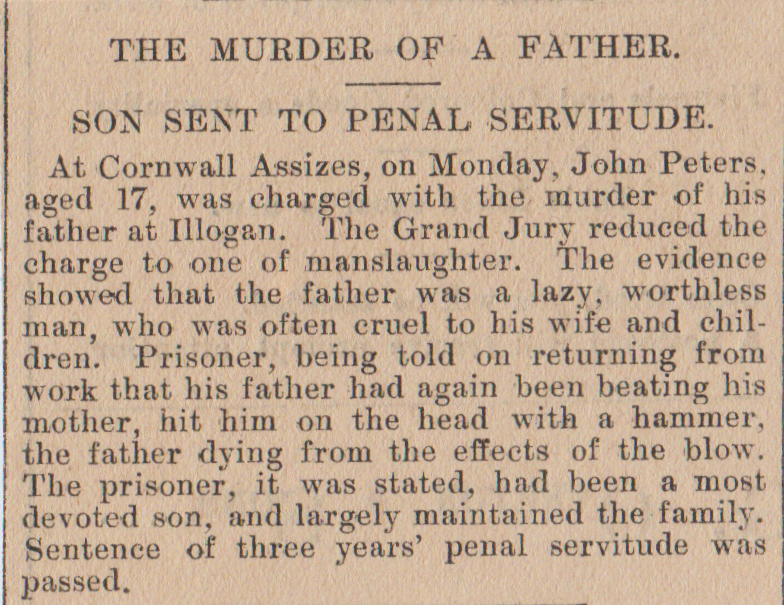1/ Longships Lighthouse Suicide, October 1861
A lighthouse keeper called Harding, while off-duty at the Land’s End structure, stabbed himself in the chest with a knife. The other two tried to save him by stopping the bleeding but the following morning they raised two black flags, the distress signal. He was taken ashore where he told authorities that he did not regret his actions. On the contrary, he tried to put the knife handle in his wound as well to make it worse. Harding died soon afterwards. Colleagues and family said he seemed to be depressed of late, and a verdict of “temporary insanity” was returned. He left a wife and three children.
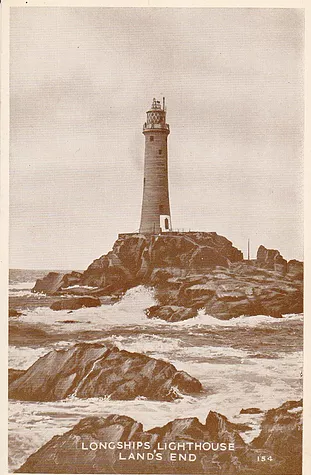
2/ Kynance Cove (Three Drowned) May 1905
Mr Matthias Dunn, a member of Cornwall County Council, took his two nephews on a boat trip round Kynance Cove, near Lizard. The boat capsized and all three were thrown into the sea. Dunn placed oars under the arms of one them, the other was a good swimmer, and after this Dunn swam to the coast to go and get help but he was unsuccessful. Meanwhile, a tug went to the capsized boat, but neither of his nephews was found.
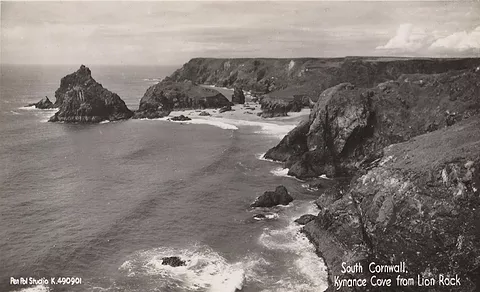
3/ Land’s End Legends, June 1869

4/ St Michael’s Mount Skeletons, January 1898
A discovery was made on the Mount when alterations were being made to the Battery of brass guns near the kitchen area. Previously it was a monastic burial ground, so when two skeletons were found 18 inches beneath the surface it probably came as no surprise. They were next to each other; one was a 40 something male; the other was a young man of about 20 years old. The one anomaly of them was the presence of a small round hole in the skull.

5/ Penzance Triple Murder/Suicide, July 1886 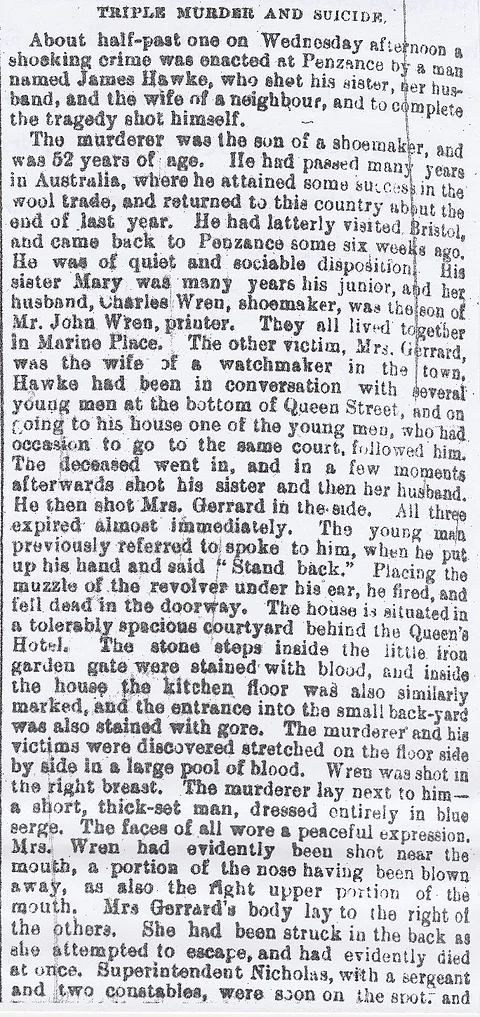
Doctor’s Grenfell, Hooking and others were in attendance, but no sign of life was visible in either victim. The murderer had been going about on the morning conversing with friends. Mr and Mrs Wren leave seven and Mrs Gerrard leaves six children.
6/ Sennen Cove (Cliff Fall) June 1857
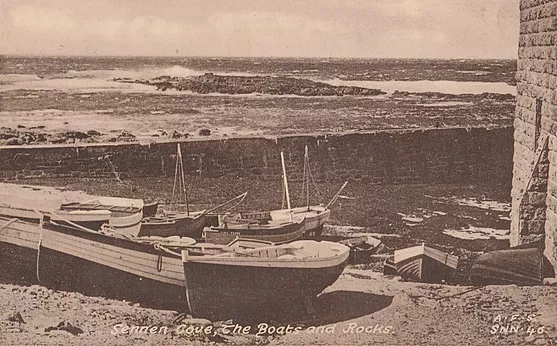
A boy and a girl went off together one summer’s morning. The 9-year-old boy was William Penrose. Between the cove (above) and Land’s End, the lad tried to grab some gull’s eggs on a cliff ledge. Inevitably he slipped and fell but the older girl held on to him, but their grip loosened and he dropped onto the rocks below, about 200 feet. When his little body was found and it was smashed to atoms.
7/ Wadebridge, April 1887
Edwin Pinch, a 15-year-old boy, hanged himself because he would rather have died than face the wrath of his father. His father had threatened to break his neck just because the lad had not given some money to his tailor, and kept it instead.
8/ Newlyn Lighthouse Explosion, January 1896
An explosion occurred at Newlyn Lighthouse near Penzance. The keeper, William Maddern went to extinguish the lamp upstairs and discovered it was on fire. In turning off the oil from the reservoir, an explosion occurred, and Maddern was soaked in burning oil. The trap door exit was in flames, so he scrambled to the parapet, and shouted for help. He was eventually rescued but the chances of him surviving are slim. (Did Maddern make it, or did he die?)
9/ Cornwall Mock Funeral, May 1905

10/ Newquay, September 1906 (Cliff Accident)
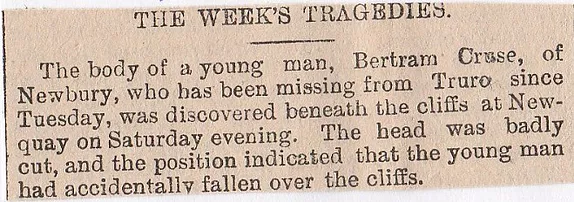
11/ Kynance Cove, May 1905 (See Number 2)

12/ Mylor Creek near Falmouth, October 1866
Henry Nicholls was for years a schoolmaster, but for the last four years, totally isolated himself from the outside world. He bought a ship’s launch and turned it into a sailing boat, then sailed the coastline, occasionally coming ashore for provisions. He was totally alone, he accepted no visitors, and during winter months he laid up in some bay. He was badly hit last winter and had been moored at Mylor Creek, near Falmouth. A cousin hadn’t seen him on deck for several days, so he rowed to the craft. He climbed aboard and went into the cabin, where he found Nicholls with a bullet wound in his head and a revolver in his hand. The gun had been put in his mouth and the trigger pulled. He’d been dead for a few days, and the verdict was “Temporary Insanity”.
13/ Penzance Cemetery Furore, July 1888
Thomas Oates had only been married a year or so when his suicide happened at Penzance Harbour when he dived in with a hundredweight of scrap iron around his neck, secured by a washing-line. Oates, along with his wife and child, lived with his mother-in-law, and it was the friction at the home that caused him to kill himself. Two thousand went to his funeral, and this is where the trouble started. When the church official had performed his duties at the graveside, he left, and then the widow and the mother were jostled, and they tried to shove them into the grave. They then tore at her dress, bonnet and gloves and tried to tear her wedding ring off her finger. Police escorted her to the sexton’s house and eventually got her home. Jeering and haranguing continued, mainly by women who were at the funeral.
14/ Mount’s Bay, (Shipwreck) April 1899

15/ Boscastle Shipwreck, April 1899
The brigantine Gazette, of Boulogne, is a total wreck at Boscastle, North Cornwall. She was laden with coal and carried a crew of four hands, only two of whom were saved.
16/ Manacle Rocks, (Gallantry Reward) April 1899

17/ Sheviock, (Child Suicide)May 1830
10-year-old Sarah Gooding, a sailors daughter, made her father angry one night, so her punishment was to make her wear her weekday clothes to church on Sunday. The child was livid and somehow got hold of an ounce of laudanum which she swallowed and died in great agony.
18/ Jacobstow, April 1872
Mr John Uglow, a prosperous farmer in the area, committed suicide just before his mother’s funeral. As the funeral was about to begin, someone asked for his whereabouts, nobody knew, so they looked around for him. He was found in a field nearby with his throat slit from ear to ear, probably due to the loss of his mother.
19/ Land’s End, (Cliff Mystery) November 1903
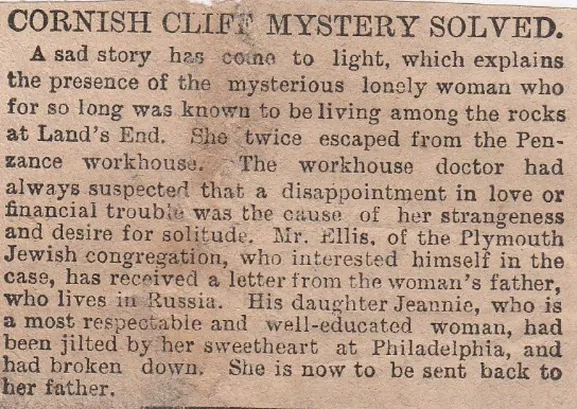
20/ St Ives Drowning, Cornwall, August 1896
At St Ives, a small rowing boat, containing two persons capsized. One of the occupants was rescued, but the other, a young man named Henry Stevenson, was drowned.
21/ Penzance Suicide, November 1875
At the main hotel in Penzance, a lad of fifteen was employed as a billiard marker. He was on duty one night, doing a good job as usual; when the hotel closed, it was noticed that the billiard table wasn’t covered or the light put out. Nicholls wasn’t to be found anywhere so another lad did the job for him and on opening the cupboard door, for the cover, he saw Nicholls suspended by a cord from a hook in the wall. The young chap was well liked and well looked after, so the reason for his tragic act is a mystery.
22/ H.M.S. HECLA/CHEERFUL COLLISION, July 22nd, 1885
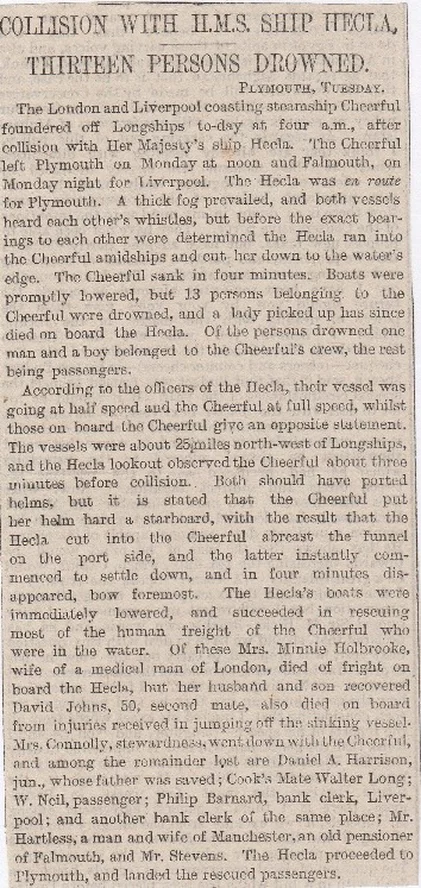
July 23rd, 1885
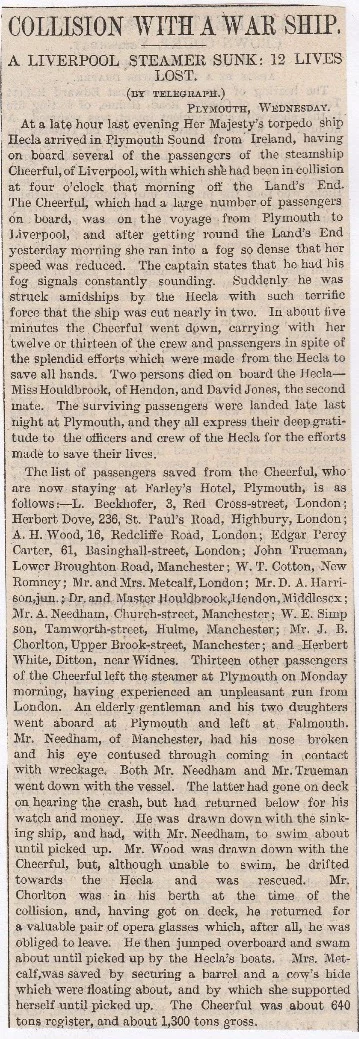
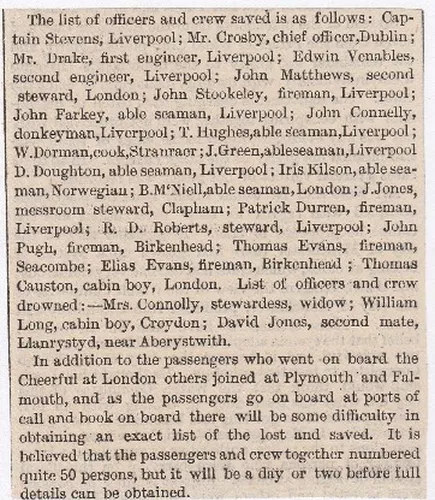
July 23rd, 1885

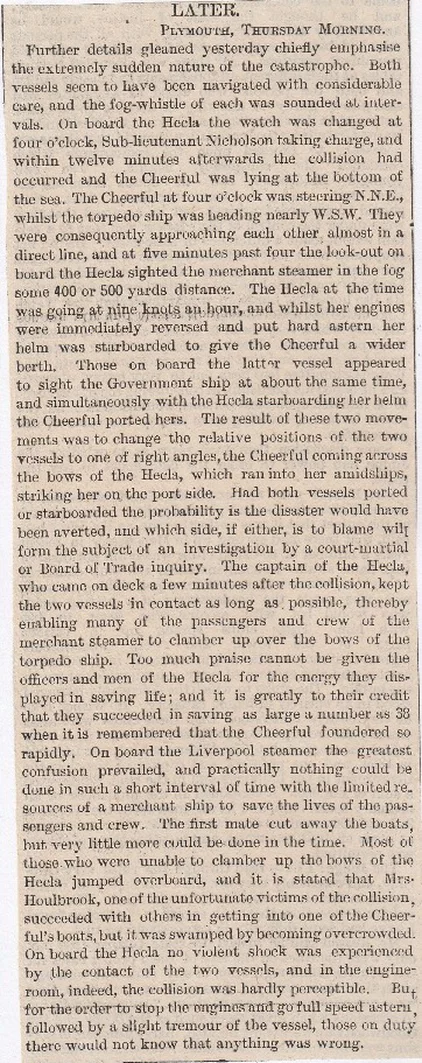
July 24th, 1885
The Loss of the Cheerful-Two of the tourists drowned by the loss of the Cheerful, which was sunk by Her Majesty’s steamship Hecla, off Lands End, were Mr and Mrs Chadwick, of Marvel Street, Patricroft, who were passengers on the Cheerful. Mr Chadwick has for a number of years been the Superintendent of the Patricroft Congregational Sunday School. They have no family.
July 25th, 1885

23/ Pendennis Castle, August 1906 (Imprisoned in a Castle Dungeon)
A terrible tale of how a child was imprisoned in a dungeon at Pendennis Castle was told at Falmouth Police Court. A pensioner and his wife named Emery, have been residing in the Castle. They adopted a child named John Henry Wynne, who is now three and a half years old. Emery worked at the barracks with some there noticing the child became emaciated and insular. The child vanished one day, and a soldiers wife thought they’d got rid of him. A search, however, revealed him to be incarcerated in a room 15 feet underground. When they saw him he was cowering under a table, and when they entered the room, the boy went straight to the stranger as if frightened by the foster mother. The boy was skeletal in appearance and filthy. The woman said he was kept there because he had “dirty habits”. The foster mother beat him with a stick, on the end of which was a piece of dried seaweed. They also had two insurance policies on the child (Hoping he’d die of natural causes?) The man was fined £5 and £3 12 shillings costs. The old bat got four months hard labour. When they were outside the court, a group of enraged women tried to tear them limb from limb and chasing the cab down the road.
24/ South Frances Mine, September 1906
One of the Basset group, South Frances Mine, in Cornwall, saw a dreadful accident resulting in three lives being lost. The dead were Captain Jenkins, Captain William James junior, and a mining student. Just as they were going down a fall of earth occurred, and they were all dead when brought to the surface.
25/ Liskeard Explosion, January 1899
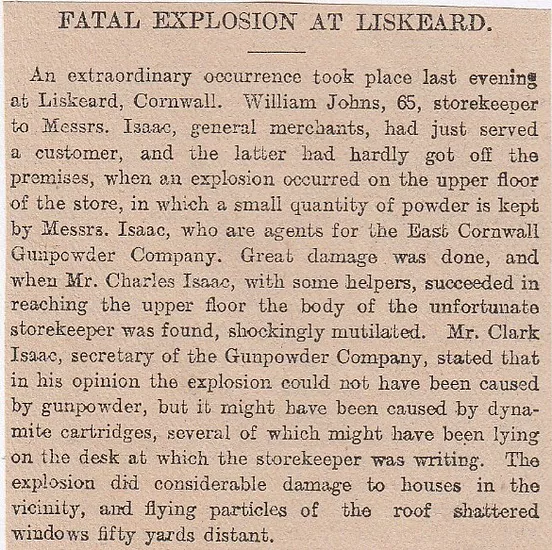
26/ Falmouth, (Warship Fatality) August 1892
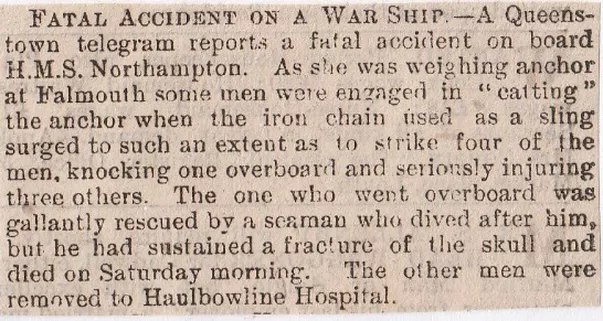
27/ Morvah Cliffs Fall, September 1894
The fearfully injured and lifeless body of Mr Taylor, eldest son of the Vicar of Morvah, was found yesterday at the foot of Morvah Cliffs. He went to bathe on Wednesday and is supposed to have fallen over the cliff to the rocks below, a hundred feet or more.
28/ Venterdon, Stoke Climsland, December 1892 (Dynamite Suicide)
James Blyth, a 27-year-old labourer, put some dynamite in his mouth and lit the fuse which was attached to it. His head was blown to smithereens and the rest of the body was badly mangled. He killed himself because he had consumption, and this had preyed on his mind, plus the fact he hadn’t two ha’pennies to rub together. Launceston Guardians had only the week before granting him relief. He was not married and relied on his brother for a roof over his head.
29/ St Mary’s Churchyard Suicide, Truro, April 1892
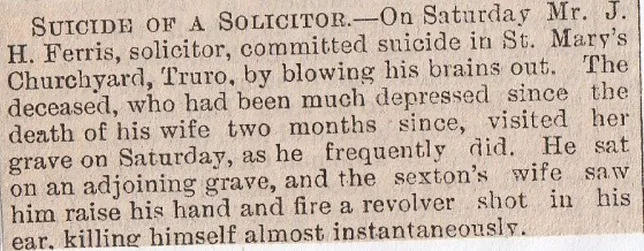
30/ Charlestown near St Austell? August 1889

31/ St Day, February 1902 (Child Remains/Incest)
At the house of an old man, named Stephen Holman, the remains of a small child were discovered. Holman’s daughter absconded a couple of days since, and thinking she had jumped down a mine shaft in order to kill herself, he tried to cut his own throat. Meanwhile, she was found in Plymouth Workhouse where she told staff that she gave birth to a child some years ago, and the father was her father! Holman, now recovered, admitted the accusation was true and that the child was stillborn so he buried it to save the embarrassment. The verdict was “Found Dead”.
32/ Brideaux Estate near St Blayzey, April 1858 (Drowning)
Major Croker of the Royal Marines Artillery was drowned, along with his coachman in a pond on the Brideaux Estate, which he rented off Sir Coleman Rushleigh. Croker was hoping to clear away the overgrown pond so he got a flat-bottomed boat to go and clear it. He and the coachman rowed out, the boat somehow capsized and both were sent into the weeds, where they became entangled and both drowned.
33/ Scilly Isles Explosion, July 1885
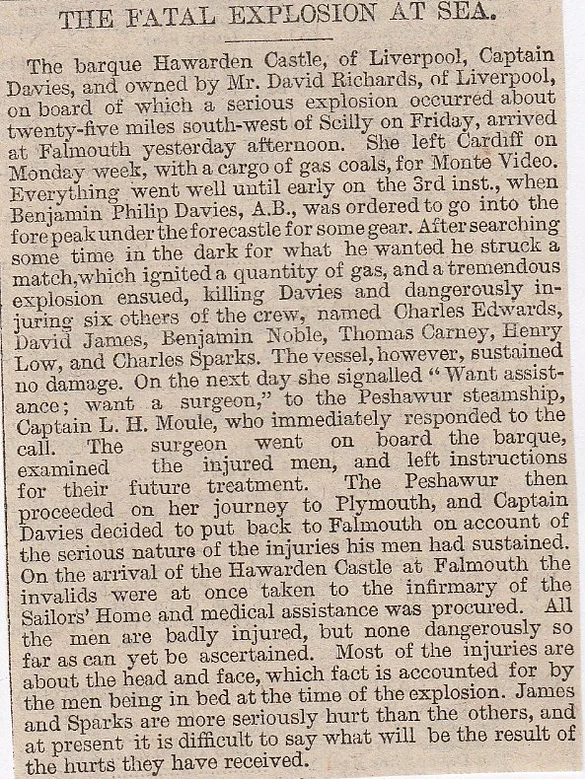
34/ Herodsfoot Powder Mills near Liskeard, (Fatal Explosion) November 1876
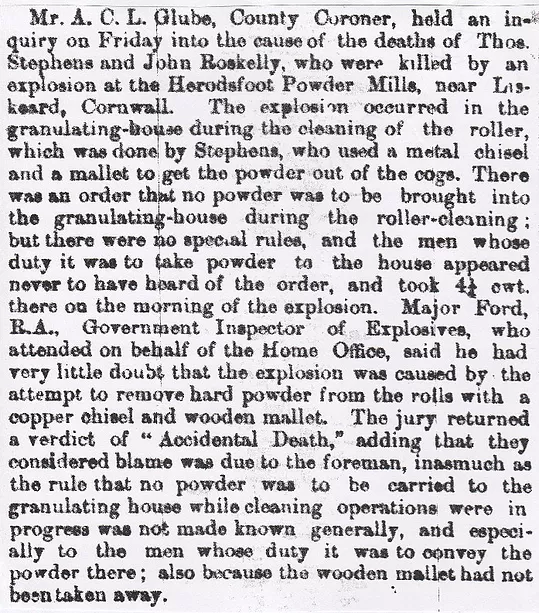
35/ Lostwithiel Suicide, February 1868
At ten p.m. on Friday, Sergeant Newcombe called at the home of a labourer named Tinney. He charged the eldest daughter with stealing bacon from her employer. When being questioned she denied all the charges but the officer found a large piece of bacon on a shelf, and the girl asked her mother if she’d bought it at Lostwithiel. The mother said “No”, and said it had been bought at Blazey. The policeman asked to see the shawl she wore in the afternoon, and she showed it to him. It had grease and salt on it, then he arrested her. She told him she would get dressed upstairs, and shortly afterwards he heard the sound of streaming water so they rushed upstairs and found she’d cut her throat. Blood was gushing out and despite attempts to save her, they were futile.
36/ St Just Cliff Death, May 1889
Eight-year-old Bessie Richard and Mary Richards, a six-year-old from St Just, went out to pick primroses. They didn’t come back at the set time so a search was made all through the night, with no sign of them. When dawn broke the next day, some flowers were found on a cliff edge known as Cornish’s Zawn, attached to Botallack Mine, and the two little girls were on the rocks below. One girl had a broken leg, the other had a broken neck.
37/ Cartha Martha House, Launceston, ( Lady’s Suicide) January 1885

38/ Truro, March 1892 (Suicide on Wife’s Grave)
Mr J.H.Ferris, Truro solicitor, and the deputy coroner of Cornwall shot himself while attending his wife’s grave. Mrs Ferris died about two months ago and Mr Ferris was depressed since her death, so he went her grave at Truro, lay down on it and shot himself in the head. He was a very popular member of the local community, also being a member of the City Council and lieutenant of the Truro Volunteers. (Is grave still there?)
39/ Bishop Lighthouse, (Keeper Disappears) December 1898
The head lighthouse-keeper, Mr Ball, at the Bishop Lighthouse, was swept away by a huge wave, while on the base of the rock. The atrocious weather and high seas meant that rescue was nearly impossible. If you see a picture of this lighthouse you will notice that it is literally a rock jutting out of the sea, with a lighthouse that has been built on it.
40/ Helston, (Mineshaft Death) April 1885

41/ Penzance Promenade, February 1864
Another one in Penzance seafront, similar to the Penzance Cemetery story near the top of the page (number 13). This story involved a lady who threw herself from the Promenade and drowned. Mr and Mrs Ibbotson from Poyle, Middlesex, their daughter, Louisa Mary a single 34-year-old lady, and their female servant, arrived at Mitchell’s Western Hotel from Torquay. Miss Ibbotson, who was an orphan had lived with her cousin, Mr P.G.Ibbotson, for thirteen years. About a year ago she became interested in religious matters (some today would say cult member, religious maniac), but was suffering physically. The doctor suggested this break in Cornwall and Devon to rejuvenate her and even a change of address was mentioned. One evening they decide to go to Lizard and Kynance Cove and returned at tea time. While tea was being prepared she got up from her chair, said “Allow me to pass for a moment” and walked out to the Promenade and dropped 12 feet into the water. She was swept out to sea and drowned. Coastguard found her body later on.
42/ Helston Suicide, January 1882
A bloke named Mildrew, who was blind, went to an outhouse and cut his throat. His mother heard a noise and wet to find out what it was. Her son had slit his throat, and for three hours he kept three grown men and his Mum at bay. He also found the razor in the straw and tried to make the gash in his throat wider. The roof was taken off, and he was kind of “lassoed”. The sheer amount of blood he lost was too much and he died shortly after.
43/ Albaston near Calstock, (Boiler Explosion) November 1885
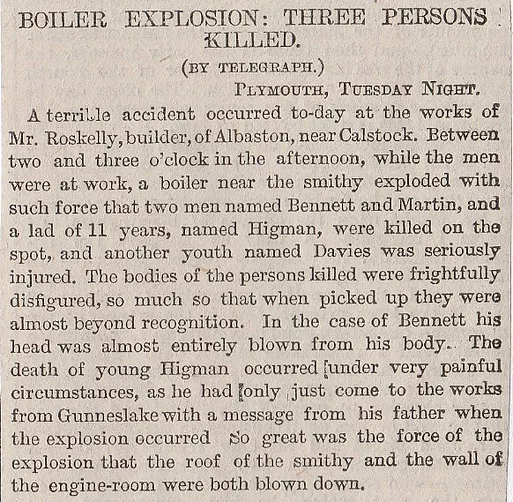
44/ Arwenack Mansion near Falmouth, January 1888 (Rear Admiral’s Suicide)
Mrs Versturme and her husband, Rear Admiral Versturme were having dinner at Arwenack Mansion, near Falmouth. She normally sang after dinner but she had a sore throat, so just tinkled the ivories instead. Mr Versturme stood next to the fireplace and put the poker in the fire. She was just starting to play when she heard a gurgling noise and saw her husband with the poker in his hand. Mrs Versturme tried to wrestle it from him and burnt herself in the struggle, and then fainted. The two made a lovely couple, and they never really had any problems until recently, when some family worries sort of upset him. His wife had cheered him up, and he told her “You are the most cheerful companion any man could have”. Ellen Davis, a servant in the house, said she heard groans coming from the drawing-room and when she went in she saw her mistress lying on the floor, and the Rear Admiral was “struggling and banging himself about”, and she managed to get the poker from his grasp. He then grabbed a lighted lamp, so she threw a rug over it in order to extinguish it. A doctor diagnosed him as having suicidal mania, and there were four puncture marks where the poker had been inserted. They were burned as well. The poker entered the peritoneum and blood oozed from the mouth, caused by swallowing broken crockery. The verdict was”Died from the effects of wounds self-inflicted while in a state of temporary insanity”.
45/ Linkinhorne, (Death in a Mine)March 1879
A few days ago a miner named William Seymour, was found dead in Phoenix Mine. It was supposed he died in a fit, and the verdict to that effect was returned at the coroner’s inquest. He was interred at Darley Chapel. A neighbour of the deceased, the next night dreamed that a gentleman had driven up in a carriage, to the mother of the deceased, and said her son was not dead but had been buried alive. The dream being rumoured about, the next night seven or eight men went to the graveyard, dug up the coffin and carried it to a chapel. They unscrewed the lid and there was the body of their comrade still living and breathing. So convinced were they, that they sat him up and attempted a revival. One of them went for a medic and when he examined the body, saying he was dead, they quickly re-interred him. The matter has caused a great commotion
46/ Mounts Bay, (Fatal Boat Accident) August 1870
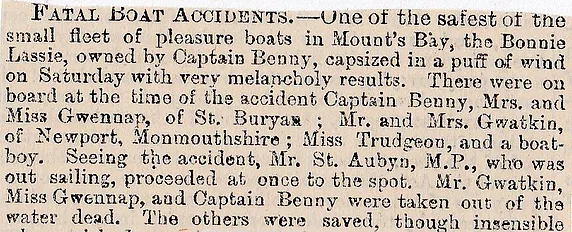
when picked up.
47/ Redruth Murder, November 1870
About 10 o’clock on Friday night some miners, in an intoxicated condition, became very excited and quarrelsome on leaving a public house in Redruth, and suddenly one named Richards was stabbed in the hip. Blood flowed profusely and it was at once evident that very serious injury had been inflicted. Medical aid quickly arrived, but the unfortunate man died in less than fifteen minutes. Two miners named Hosking and Allen, employed at Carn Brea Mine, have been apprehended.
48/ Penzance Poisoning, December 1870
49/ Message in a Bottle, Penzance November 1870
50/ Messages from the Sea December 1870 (La Guaira is in Venezuela)
Two bottles, strung together and securely sealed, have been washed on to the beach at Hayle in Cornwall, with one of them containing three letters directed to Hamburg and two sixpences to defray the cost of postage. The other bottle contains a pint of rum to recompense the finder for his trouble in posting the letters, which are from the Danish brig “Anne Georgiana”, bound to La Guayra.
51/ Fatal Stabbing in Probus, November 1870
A shocking affair occurred one Friday afternoon on a farm in the village of Probus, near Truro. A steam threshing machine was at work, and a labourer named James Miners was employed in forking up the sheaves to the machine. Lewis Webb was feeding, and having complained without effect that the sheaves were being sent up too quickly, he threw one or two down upon Miners, who became excited, and told him if he did so again he “would give him something”. Webb then turned around and was approaching Miners, when the pitchfork held by the latter penetrated his body. The poor fellow suffered great agony and died about three hours later. Miners was secured and handed over to the police.
52/ Fatal Explosions in Cornish Mines, November 1870 (Wheal Frances Mine/Wheal Agar Mine)
53/ Blisland, Death from Exposure. November 1870
54/ A Fatal Accident to Lizard Lifeboat, January 1866.
55/ Burnt to Death at St Germans, January 1866
On Sunday morning the charred remains of a labourer named William Knight, aged sixty-one, were found in a limekiln near St Germans. The unfortunate man was addicted to drink and had been accustomed to sleep in outhouses and near limekilns. He was seen in n intoxicated state on Saturday night, and it is supposed that while standing near the edge of the kiln he lost balance and fell into the pit where he met with his fearful death.
56/ St Allen Powder Mills Explosion, February 8th, 1866.
An explosion, the second within 18 months, took place at the St Allen Powder Mills, near Truro, on Monday afternoon. Two men were dreadfully burnt. The building in which they were working, and in which the explosion, from some cause at present unknown, took place, was completely destroyed.
February 17th, 1866.
The two men referred to in The Times as having sustained serious injuries by the explosion at the powder mills near Truro, a week ago, died on Wednesday at the Cornwall Royal Infirmary.
57/ Maker Vicar Dies in the Pulpit, May 1866.
58/ Child Murders Child, St Stephen, near St Austell. November 1866
59/ Fatal Gun Accident, Newlyn. January 1867
A farmer’s son, named Alfred Hotton, of Newlyn, West Cornwall, met with a shocking accident while out on a shooting expedition on Monday. within a couple of hours of the unfortunate young man leaving his home, he was found a corpse, his three dogs sitting close to the body. /it is believed that the deceased had got out of what is known as a shale pit, where he had been hiding from the birds, and was in the act of reaching for his gun with the barrel towards him when the triggers caught by some means and the fatal accident happened. The charge had entered his mouth, taking an upwards course, and lodged into his head.
60/ Tintagel Lunatic Kills Carer and Himself, January 1867.
61/ Padstow Lifeboat Accident, February 1867 (Five Crew Drowned)
62/ Attempted Wife Murder, Falmouth. March 1867.
63/ Fatality near Bodmin Railway Station, October 1903.
64/ Fatal Accident at Bishop Rock Lighthouse, August 1903. (see No 39 also)
65/ Wanderer found near Penzance, September 1903. (See No.19 also)
66/ Bodmin Prison Suicide, July 1904.
67/ St Columb Murder/Suicide, June 1904.
68/ Gamekeeper Killed on Tregothnan Estate, near Truro. January 30th, 1904.
The inquest into the death of Henry Osmond, gamekeeper, found dead in a wood on the Tregothnan estate, near Truro, was opened yesterday. The coroner said that at a later stage a witness would state that just after Osmond was seen alive on Tuesday evening, he heard three shots fired in rapid succession in Nance Mabyn little coverts, where the body was found. The body was identified by John Dew, the head gamekeeper for Lord Falmouth, the inquest was adjourned for three weeks, by which time Robert Bullen, who admitted to shooting at Osmond, might be able to attend. Bullen, however, is in a serious condition, and his recovery is doubtful.
Saturday, February 20th, 1904. (The Inquest)
69/ Nit0-Glycerine Explosion near Hayle (Four Killed) January 6th, 1904.
Friday, March 18th, 1904. (The Final Report and Conclusion)
70/ Body of a Baby Found near St Ives. February 1906
71/ Artist’s Shocking Death near Boscastle, August 1906.
Miss Edith Elcock, who was thirty-five years of age, and who came from Handsworth, Birmingham, was out photographing on Tuesday at Boscastle, Cornwall and was walking along the cliff. She stopped to take a snapshot of a friend by who she was accompanied and stood with her back to the edge of the cliff, forgetting where she was. The lady stepped back to get the focus, and slipped and fell over the cliff, and apparently met her death before she reached the bottom. A boat put off, and her body was recovered and conveyed back to her lodgings.

